1977 Ford 7600; a classic utility winner!
Posted by Chris Graham on 20th October 2023
The Ford 7600 was a popular utility tractor back in the late 1970s and Dave Broadway has a fine example, as Bob Weir reports.
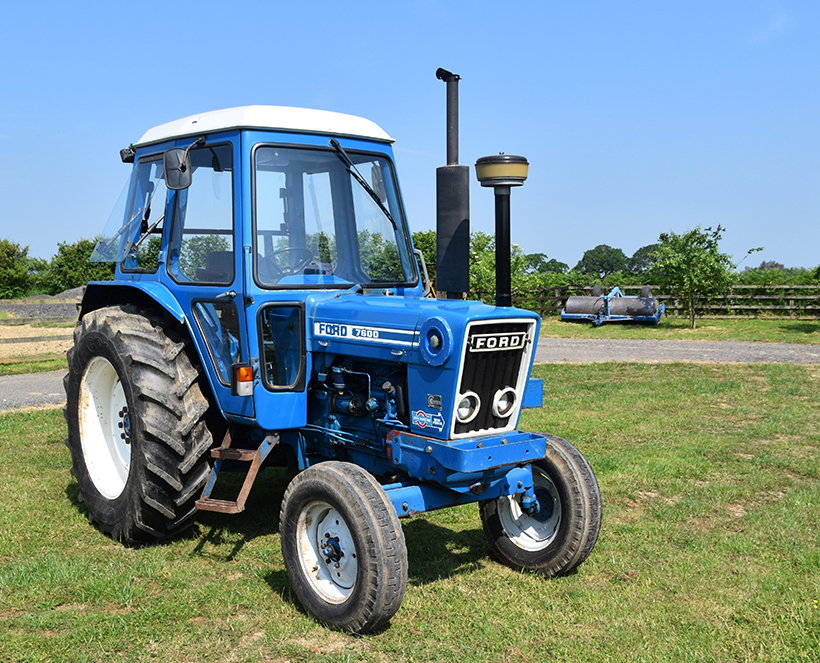
The Ford 7600 was a popular tractor during the late 1970s. Its clean lines and modern cab made it a winner.
Although the Severn Valley is now primarily farm land, it was once the home of the Industrial Revolution. During the latter part of the 18th century, the area gave the world its first iron wheels, steam-powered locomotive and famous iron bridge. This legacy is still around today, with plenty of superb Ford and Fordson tractor collections in the area to whet the appetite.
Dave Broadway is a plant hire operator and has lived in the area all his life. “I come from a farming background,” he explained. “My grandfather owned acreage that’s still in the family. The area around here is a tight-knit community, and the Broadways have been involved in it for as long as I can remember.”
Young driver
Like a lot of lads brought up on a farm, Dave also learned to drive tractors at an early age. “My father was a working farmer and he used to sit me on various tractors while I was growing up,” he recalls. “I remember driving my first one – a little grey Fergie – when I was just six years old. Then, once I was a bit older, I’d regularly drive a Fordson Major. I suppose tractors are in the blood, and there’s just no cure for that now!”
Dave went to a local school and, from an early age, seemed destined to work on the land. “When I left I started working on a local agricultural estate, driving tractors,” he said. “I was driving mainly Masseys at that stage, but I remember there were plenty of Fords in the area, too.”
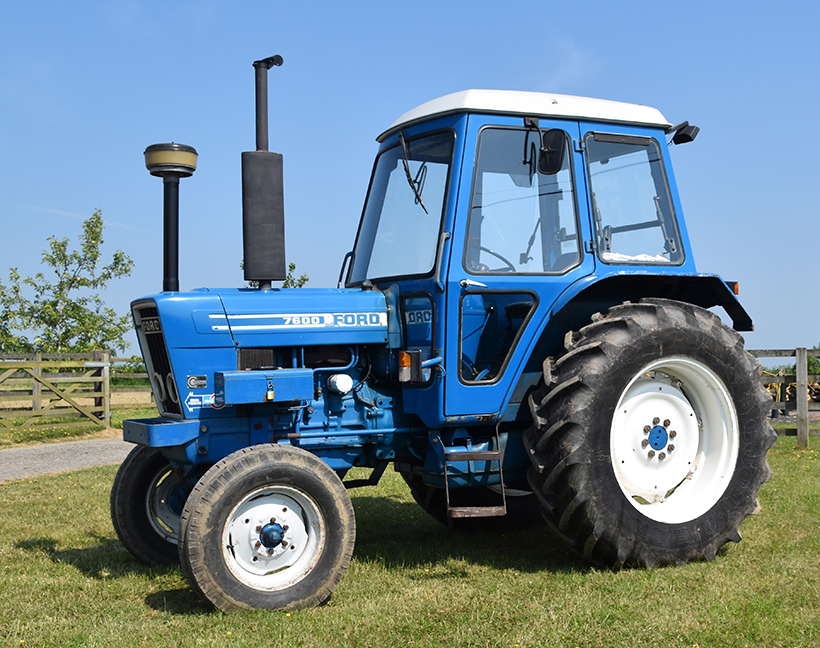
Early models like Dave’s used a 4.2-litre engine delivering 96.7hp. A turbo provided most of the grunt.
Dave worked on various farms, before changing career and becoming a lorry driver. He eventually ended up joining the local electricity board. “I worked for what was then the MEB (Midland Electricity Board) for many years, and am still one of its sub-contractors,” he told me. “It was satisfying work and allowed me to stay in the area.”
He started collecting old tractors back in the 1980s, and has acquired several different marques over the years. But he’s always had a soft spot for Ford and Fordson models. “I’ve been a big fan of the blue machines ever since I was a teenager,” he said. “The first Ford I bought was a 4000, but that’s been moved on. I’ve bought and sold other Ford tractors over the years, including a 7610 and a 7810. I also acquired several New Hollands after the takeover.”
Local is best!
Dave finds his tractors from a number of different sources, and always prefers local machines. “Apart from the 7600, I currently have a 5000 Pre-Force Select-O-Speed, a 6610, a 7610, an E1A Major, a County E1A Crawler and a New Performance Super Major. I’m also a member of the Brimfield Vintage Club, which is based in Ludlow. Apart from the real thing, I also collect scale-model tractors, and most of those are still in their original boxes.”

The Q ‘bubble cab’ was quiet and a big hit with drivers.
Dave is a great believer in the idea that old tractors survive best when used regularly, and a number of his current collection are still capable of putting in regular shifts. “I’m firmly of the opinion that vintage and classic tractors don’t like standing idle. For a start, all the seals tend to go hard due to a lack of oil circulation, and rust can gain a hold internally for the same reason. So I’m determined that such problems won’t be allowed to arise with my 7600.”
The 7600 was introduced in 1975, and was tasked with the job of replacing the very popular 7000 model. But Ford rose to the challenge, and the new model represented an all-round improvement.
Power output was a key factor at that time, and the 7600 was fitted with the Ford’s own turbocharged, 4.2-litre engine that developed 97hp. Later versions used a 4.41-litre unit, and the model was equipped with a lightweight frame weighing just 3.3 tons. There were also cosmetic changes, with the grille on the 7600 being painted black, plus a new set of decals. Other alterations included a new air cleaner and exhaust silencer.
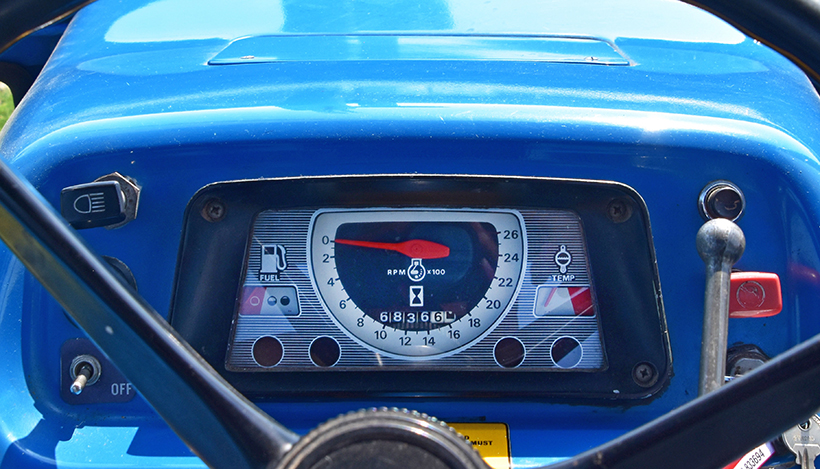
The dashboard is well laid out and very user-friendly.
However, arguably the biggest improvement was the introduction of the Q-cab (Quiet Cab). This appealed to a lot of buyers, and the new design was quickly nicknamed the ‘bubble cab’. It offered a significant upgrade over what had gone before, and driver comfort was much improved. Noise levels were reduced to 85dB, which was low enough to allow operators to listen to the optional radio.
Other desirable features of the new cab included reduced vibration levels, wide-opening doors, good control layout and excellent visibility. Standard equipment featured a sun visor, rear view mirror, two-speed windscreen wiper and a padded toolbox that doubled up as a passenger seat. Air conditioning was made available as an optional extra.
Simple controls
Driving the tractor was also straightforward. The operator has a pair of floor-mounted levers, located centrally, to control the constant-mesh gearbox. The shorter of the pair selects high and low range, while the longer one controls the four-speed gearbox and reverse. Buyers could also have opted for Dual-Power, which offered on-the-move gear changes using a clutch-less splitter, effectively doubling the number of gears in each range.

The original dealer’s plate and sought-after ‘Dual Power’ decal both add provenance to Dave’s example.
Ford had its own spin on the benefits of Dual-Power, suggesting that when the driver was operating in Hi, they could pull back the lever on the right of the console to ‘Lo’, decreasing the speed of the tractor by roughly a quarter, and increasing pulling power by almost 30%.
However, despite the many positives, the Ford 7600 still suffered with a few issues. Ford engines from this period were notorious for ‘going porous’, a major symptom of which was the presence of water in the oil, rather than oil in the water. The company somewhat skirted the issue by blaming metal quality, then introduced the use of coolant additive and a water filter as partial solutions. But the problems rumbled on for a long while, and damaged Ford’s reputation as a result. Porous engines were typically replaced under warranty, with the improved design being identifiable by the cross pattern on the engine block casting.
Tinwork corrosion could be a problem, too, although this was an issue for many motor manufacturers during the 1970s. Causes were numerous, but included the quality of the steel being used as well as poor paint preparation and spraying coverage. Areas particularly affected on this tractor were the cab and windscreen seals. Rust would also gain a hold in and around many of the joints in the metalwork.
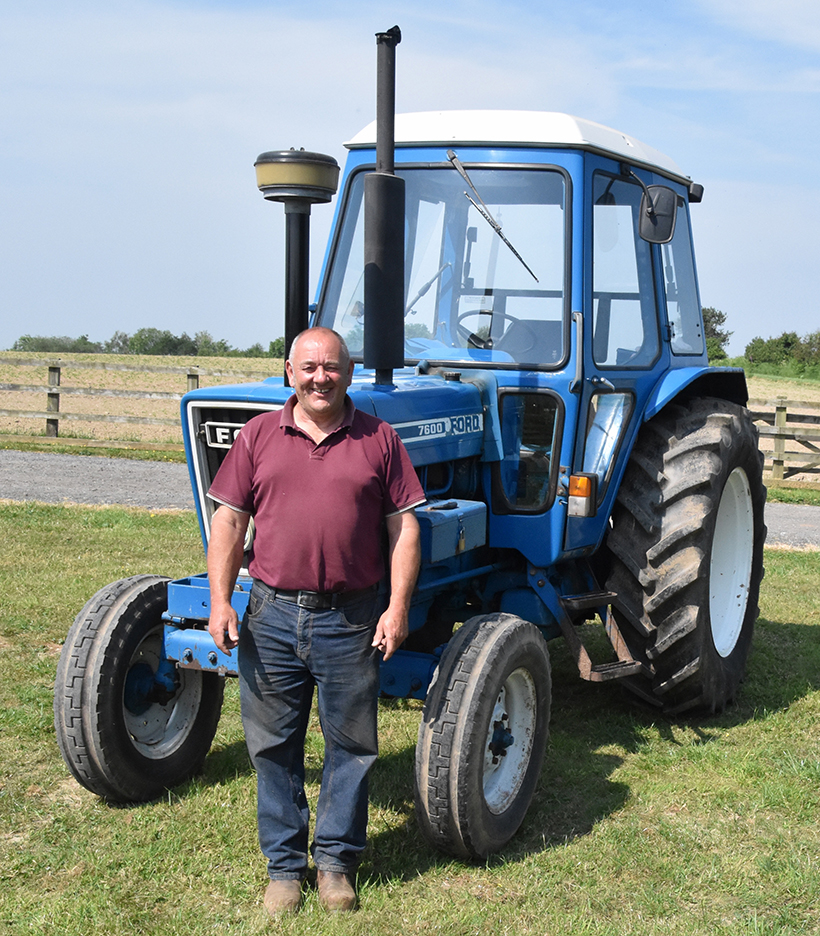
Dave Broadway is a big Ford and Fordson tractor enthusiast.
Much appreciated
Despite these downsides, most farmers gave the tractor the ‘thumbs up’. As a result, the 7600 was soon setting the standard for mid-range tractors, especially if it was equipped with Dual-Power, load monitor draft control, and a Q-cab. The lively engine meant the tractor had sufficient power to be a forage harvester, and was flexible enough to be used as a yard scraper. The model remained a popular choice with farmers and contractors until production was phased-out in 1981.
“My 7600 started life at a farm at Tenbury Wells, in Worcestershire,” Dave explained. “It was new in 1977, to a farmer called Mr Bourne. He drove it himself and kept the machine for many years. It was specified with a lot of options from the factory, including Dual-Power, load monitor and an assister ram. About the only extra it lacked was the 1,000rpm PTO.”
Fortunately for Dave, his brother was working with the owner at the time. So, when Mr Bourne decided to sell the tractor in 2013, he got straight on the ‘phone to give Dave the good news. “Having talked with my brother, I visited Tenbury Wells to check the tractor out for myself,” he recalls. “The Ford was still in its working clothes and, on first inspection, appeared to be in reasonable condition. Mr Bourne told me that he wanted the tractor to go to a good home; preferably to a Ford enthusiast who would look after it. So we quickly came to an arrangement and I brought the tractor home on the back of my low-loader.”
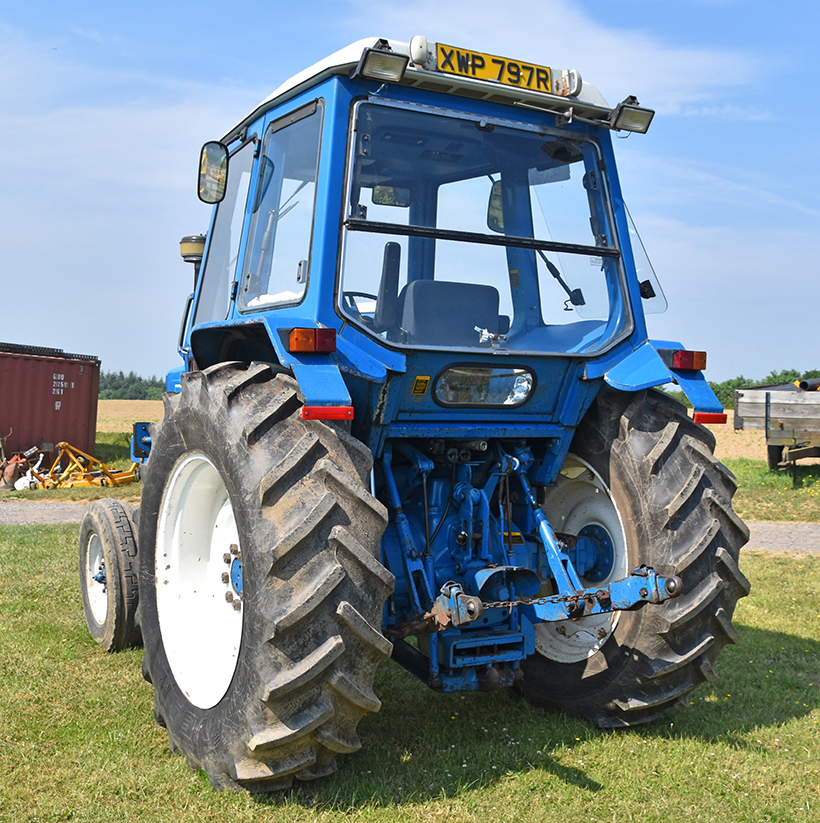
The Ford 7600 was a Jack-of-all-trades tractor; a genuinely sturdy, utility machine.
Having bought the 7600, Dave spent a bit of time taking stock. Like a lot of owners of his generation, he was brought up with tools and is used to carrying out his own servicing and maintenance. “My first job was to give the whole tractor a thorough clean,” he recalls. “I was still working full-time at that stage, so everything the 7600 needed had to be tackled in my spare time. I spent several days steaming it all off and the cab, in particular, needed plenty of work. While I was at it, I also gave the tractor a service.”
Sound mechanicals
According to Dave, the tractor’s mechanics were sound, and the bodywork was in reasonable condition. “Rust was a big problem with tractors from this era, but this one had obviously been stored under cover,” he added. “The engine also ran well, which was a big plus point given Ford’s reputation for porous cylinders.”
Once the tractor had been given its makeover, Dave wasted little time in putting it back to work. He owns a bit of land, and the sound of the 7600’s turbo soon became a familiar one in the neighbourhood. “I still use the tractor for haymaking,” he explained. “It’s only got 6,800 hours on the clock, which isn’t a lot given its age. I also use it for mowing and baling.”
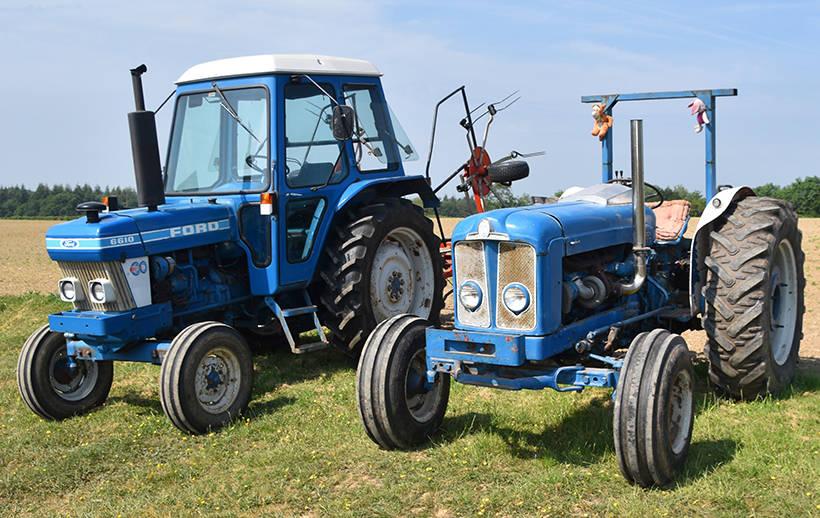
This Ford 6610 and the New Performance Super Major beside it are two more of Dave’s favourite tractors.
Dave is also a big fan of club road runs, and the 7600 has become his regular runabout. “I enjoy driving it on the road, and am happy to say that the Ford is perfectly capable of keeping up with the traffic. Fortunately, I live in a rural community and there are very few dual carriageways. Thanks to the turbo, the engine has plenty of power, and the handling is straightforward. The gearing is ideal for road work, which is just as well as there are lots of hills in the area. Thanks to the cab, I also manage to stay dry.”
Dave also likes taking the Ford along to club working days. “Luckily, there are quite a few in Shropshire,” he explained. “I usually pair it with my Bamford 12/30 two-furrow conventional plough. Everybody chips in and, weather depending, we usually put on a good show. I’m also thinking of trying my hand at some match ploughing, if I can find the time. There are plenty of good clubs around here and competition is keen.”
While I was packing my camera away, I asked Dave what Ford and Fordson tractors have meant to him throughout his life. “I like Ford tractors best of any of them,” he laughed. “They’ve always been my cup of tea, and given me lots of enjoyment.”
This feature comes from the latest issue of Ford & Fordson Tractors, and you can get a money-saving subscription to this magazine simply by clicking HERE
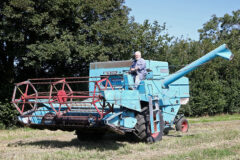
Previous Post
1970 Ransomes Crusader 2800B combine in action this summer
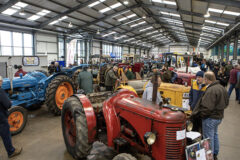
Next Post
Newark Vintage Tractor & Heritage Show ticket offer



